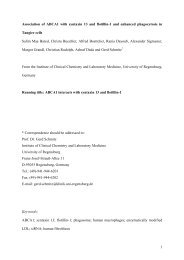SUNDAY, DECEMBER 4- Late Abstracts 1 - Molecular Biology of the ...
SUNDAY, DECEMBER 4- Late Abstracts 1 - Molecular Biology of the ...
SUNDAY, DECEMBER 4- Late Abstracts 1 - Molecular Biology of the ...
You also want an ePaper? Increase the reach of your titles
YUMPU automatically turns print PDFs into web optimized ePapers that Google loves.
<strong>SUNDAY</strong><br />
integrin to trigger <strong>the</strong> aggregation <strong>of</strong> lipid raft. The duration <strong>of</strong> lipid-raft aggregation was<br />
extended from 10 minutes (induced by ligand-coated micro-bead) to 2 hours (induced by ligandcoated<br />
Qdot), and finally <strong>the</strong> aggregate reached a diameter around 5 micrometers. In our<br />
studies, RGD-coated Qdot bound to a small number <strong>of</strong> integrin proteins may provide an<br />
effective means to observe <strong>the</strong> early events <strong>of</strong> lipid raft aggregation in a living cell.<br />
2003<br />
<strong>Molecular</strong> Mechanism <strong>of</strong> F-BAR Protein Pacsin2 in Caveolae Biogenesis.<br />
Y. Senju 1 , S. Suetsugu 1 ; 1 Institute <strong>of</strong> <strong>Molecular</strong> and Cellular Biosciences, The University <strong>of</strong><br />
Tokyo, Tokyo, Japan<br />
Protein kinase C (PKC) and casein kinase substrate in neurons 2 (Pacsin2) belongs to <strong>the</strong><br />
EFC/F-BAR domain protein family and deforms membrane. The N-terminal F-BAR domain <strong>of</strong><br />
pacsin2 forms a crescent-shaped dimer with a positively charged surface. The C-terminal SH3<br />
domain associates with dynamin2, a GTPase implicated in vesicle endocytosis. Therefore,<br />
pacsin2 is involved in membrane invaginations including caveolae (Senju et al., 2011). Previous<br />
study has demonstrated that <strong>the</strong> cells overexpressing pacsin2 showed membrane invaginations.<br />
However, <strong>the</strong> number <strong>of</strong> membrane invagination was larger in <strong>the</strong> cells overexpressing pacsin2<br />
F-BAR domain than in <strong>the</strong> cells overexpressing pacsin2 full length, which was interpreted as<br />
autoinhibition <strong>of</strong> pacsin2 resulted from <strong>the</strong> intramolecular interaction between F-BAR domain<br />
and SH3 domain. Because pacsin2 has been identified as a PKC substrate, we investigated <strong>the</strong><br />
autoinhibition mechanism based on <strong>the</strong> phosphorylation <strong>of</strong> pacsin2 by PKC. First, we performed<br />
an in vitro kinase assay, and confirmed that PKC actually phosphorylated pacsin2. Then, we<br />
generated two different pacsin2 mutants by substitution with ei<strong>the</strong>r alanine or glutamic acid, and<br />
identified <strong>the</strong> phosphorylation site in pacsin2 by in vitro kinase assay. Next, we generated a<br />
phospho-specific antibody, and confirmed that endogenous pacsin2 was phosphorylated after<br />
<strong>the</strong> PKC activator PMA treatment using immun<strong>of</strong>luorescence microscopy and western blotting<br />
analysis. The number <strong>of</strong> membrane invaginations induced by phospho-mimic mutant <strong>of</strong> pacsin2<br />
was lesser than that induced by wild-type pacsin2. After <strong>the</strong> PMA treatment, <strong>the</strong> number <strong>of</strong><br />
membrane invagination was decreased in <strong>the</strong> cells expressing wild-type pacsin2, but <strong>the</strong>re was<br />
no significant effect in <strong>the</strong> cells expressing ei<strong>the</strong>r phospho-mimic, phospho-deficient mutant, or<br />
F-BAR domain <strong>of</strong> pacsin2. Therefore, <strong>the</strong>se data suggest that phosphorylated pacsin2 prefers<br />
an open protein conformation that permits interaction with its partners such as dynamin2. The<br />
interaction <strong>of</strong> pacsin2 with dynamin2 probably caused dynmin2-induced scission <strong>of</strong> membrane<br />
invaginations, which in turn decreased <strong>the</strong> number <strong>of</strong> pacsin2-induced membrane invaginations.<br />
Fur<strong>the</strong>r experimentation will be required to test this hypo<strong>the</strong>sis and reveal <strong>the</strong> physiological role<br />
<strong>of</strong> pacsin2 in caveolae biogenesis.<br />
2004<br />
Identification and characterization <strong>of</strong> atypical FYVE Domains for specific interaction with<br />
phospholipids.<br />
J-E. Gil 1 , I-S. Kim 2 , B. Ku 1 , W. Park 1 , B-H. Oh 1 , S. Ryu 2 , W. Heo 1 ; 1 Korea Advanced Institute <strong>of</strong><br />
Science and Technology, Daejeon, Korea, 2 Pohang University <strong>of</strong> Science and Technology,<br />
Korea<br />
Interactions <strong>of</strong> lipid binding domains with intracellular lipids play a significant role in regulation <strong>of</strong><br />
numerous signaling and cellular mechanisms. To characterize interactions <strong>of</strong> lipid binding<br />
domains with phospholipids, five classes <strong>of</strong> lipid binding domains were screened by fluorescent<br />
imaging and classified based on <strong>the</strong>ir subcellular localizations. Six <strong>of</strong> over one hundred kinds <strong>of</strong><br />
lipid binding domains were localized in <strong>the</strong> plasma membrane where a number <strong>of</strong> signaling<br />
cascades are generally initiated. Interestingly, we found FYVE domain <strong>of</strong> ZFYVE27 which is
















